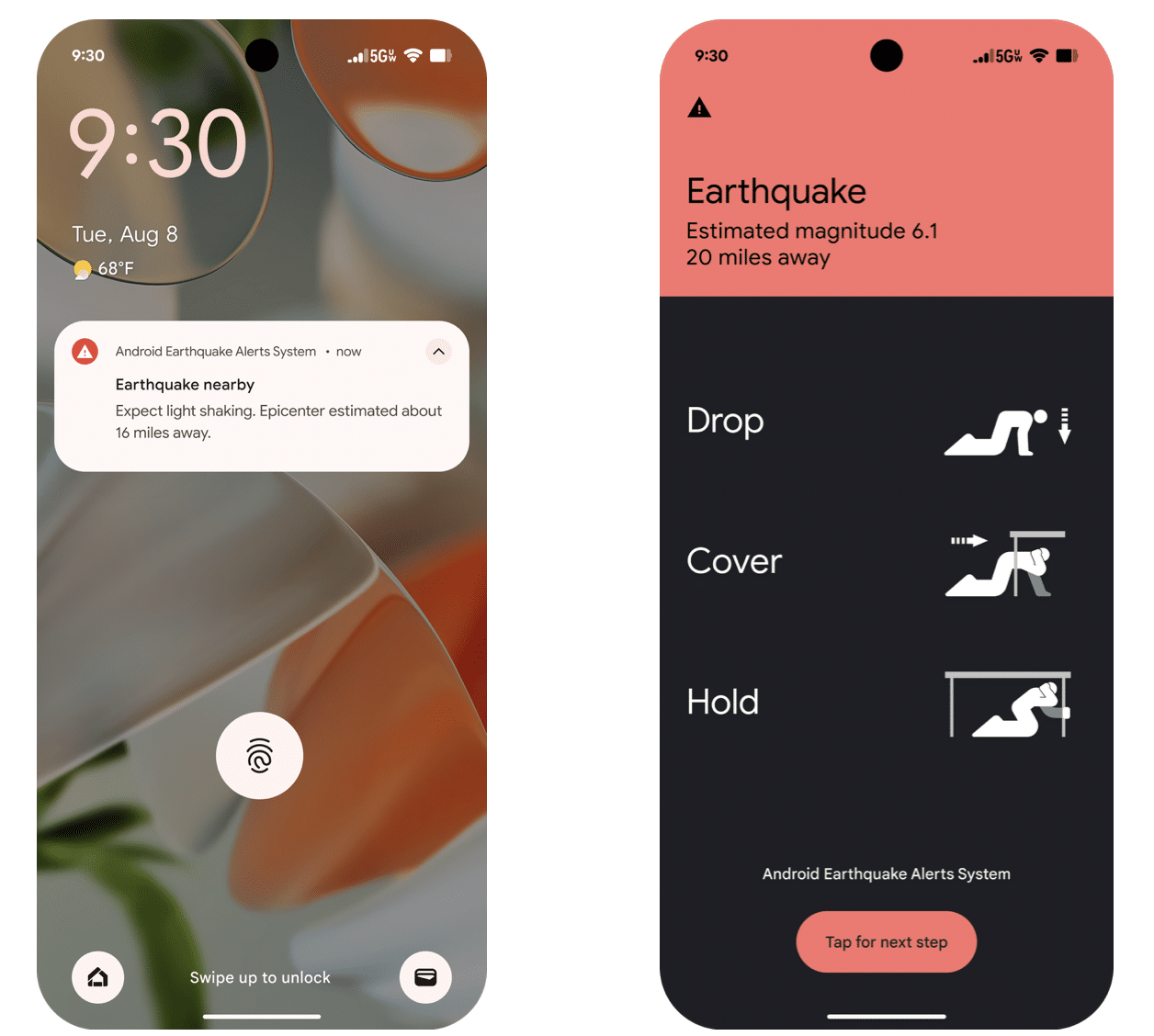Google’s earthquake alert system shows two notifications to Android users. (Credit: Google Crisis Response)
Potentially Life-Saving Alerts Now Reach 2.5 Billion People In 98 Countries Through Their Google-Based Phones
In a Nutshell
- Over 11,000 earthquakes were detected by Android phones from 2021 to 2024, with 85% matching traditional seismic catalogs.
- The system now delivers early warnings to 2.5 billion people across 98 countries — many without access to traditional alert systems.
- Accuracy has improved to rival national warning networks, with magnitude estimate errors dropping from 0.50 to 0.25.
- Survey results from 1.5 million users show 85% rated the alerts “very helpful” and 84% say they trust the system more after using it.
BERKELEY, Calif. — Getting a warning on your phone seconds before an earthquake hits isn’t science fiction anymore; it’s reality for millions of people worldwide. Scientists at Google and UC Berkeley have turned ordinary Android smartphones into the world’s largest earthquake detection network, reaching 2.5 billion people across 98 countries.
Over three years, this smartphone-based system detected more than 11,000 earthquakes and delivered alerts with accuracy matching traditional seismic monitoring systems. For earthquake-prone regions without expensive monitoring networks, a simple Android phone could mean the difference between life and death. The research behind this remarkable system is now published in Science.
How Android Phones Detect Earthquakes Using Built-In Sensors
Android phones work as earthquake detectors by using their built-in accelerometers, the same motion sensors that rotate your screen when you flip your device. When a phone sits still, it continuously monitors for sudden movement spikes matching earthquake wave patterns.
“When an individual phone triggers, it sends a message to Google servers with acceleration information and an approximate location,” the researchers, led by Richard Allen, director of the Berkeley Seismology Lab, explain in their paper.
Google’s algorithms then analyze reports from multiple phones to determine if the pattern represents a real earthquake rather than construction work or passing trucks.
This crowd-sourced approach fundamentally changes earthquake monitoring. Traditional systems rely on expensive seismic stations costing hundreds of thousands of dollars each, requiring ongoing maintenance that many earthquake-prone regions simply can’t afford.
The Android system automatically runs on most devices through Google Play Services, meaning roughly 70% of the world’s smartphones participate in this detection network without users doing anything special.


System Accuracy Rivals Professional Earthquake Networks
During the study period from April 2021 to March 2024, the Android Earthquake Alerts system detected an average of 312 earthquakes monthly, ranging from magnitude 1.9 to 7.8. Crucially, 85% of these detections matched earthquakes listed in traditional scientific catalogs, proving the system’s reliability.
Accuracy improved dramatically as Google’s engineers refined their algorithms. Early magnitude estimates had a median error of 0.50, dropping to just 0.25 by study’s end, rivaling the performance of Japan’s national earthquake warning network.
The system delivers two warning types based on predicted shaking intensity. “TakeAction” alerts break through all phone settings for areas expecting strong shaking, taking over the entire screen and playing loud sounds while displaying instructions to “Drop, cover and hold on.” “BeAware” alerts appear as standard notifications for lighter shaking areas, still providing valuable safety information.

Turkey Earthquake Response Highlights System Improvements
The system faced its biggest test during the catastrophic February 2023 earthquakes in Turkey. The first quake, measuring 7.8 magnitude, killed tens of thousands and revealed both the system’s potential and limitations.
Initially, the system underestimated the first earthquake’s size, providing a magnitude estimate of 4.5 instead of 7.8. However, researchers used this experience to improve their algorithms. When they tested updated software on the same earthquake data, results were dramatically better: the system would have detected the earthquake in 6.3 seconds and closely estimated a magnitude of 7.4, potentially warning 67 million people.
During a magnitude 5.7 earthquake in Nepal, the system delivered over 10 million alerts, with some people receiving warnings up to 60 seconds before feeling shaking.


Users Report High Satisfaction with Earthquake Alerts
Survey responses from over 1.5 million alert recipients revealed overwhelming satisfaction with the system. An impressive 85% rated alerts as “very helpful”—even among those who didn’t feel earthquake shaking during the event.
Results showed 36% of people received alerts before feeling shaking, 28% during earthquakes, and 23% afterward. Among recipients of urgent TakeAction alerts, 28% followed recommended “drop, cover, and hold on” responses, higher compliance than previous earthquake warning studies.
Trust remains strong: 84% of respondents said they would trust future alerts more based on their experience, while only 3% expressed decreased trust. After three years of operation, fewer than 0.1% of users have disabled earthquake alerts entirely.
Before Android’s system launched, only 250 million people worldwide had earthquake early warning access. Countries with high seismic risk but limited resources, including nations in Central Asia, South America, and parts of Africa, suddenly gained access to potentially life-saving technology.
The system detects earthquakes in remote locations where traditional networks would never be cost-effective, even identifying offshore earthquakes up to 100 kilometers from coastlines when they reach magnitude 4.5 or higher.
Beyond emergency alerts, this technology could help identify unknown faults beneath cities, provide rapid post-earthquake damage assessment, and improve regional hazard models worldwide. For millions living in earthquake-prone areas without traditional monitoring, an Android phone represents their best defense against one of nature’s most unpredictable threats.
Disclaimer: This article summarizes findings from a peer-reviewed study published in Science on July 17, 2025. While the Android Earthquake Alerts system shows promising accuracy and reach, its performance can vary by region, phone density, and event size. The user survey data is based on voluntary responses and may not reflect the full user population. As with all early warning systems, predictions are limited by the physics of earthquakes and may not always provide actionable lead time in all scenarios.
Paper Summary
Methodology
Researchers analyzed three years of data from the Android Earthquake Alerts system, which uses accelerometers in Android smartphones to detect earthquakes. When phones detect earthquake-like motion, they send data to Google servers that analyze patterns from multiple devices to confirm real earthquakes. The system was evaluated against traditional earthquake catalogs and compared to established early warning systems in Japan and the United States. User feedback was collected through surveys completed by over 1.5 million alert recipients.
Results
The system detected 11,231 earthquakes from April 2021 to March 2024, with 85% matching traditional earthquake catalogs. Detection accuracy improved significantly over time, with magnitude estimation errors dropping from 0.50 to 0.25. The system delivered alerts in 98 countries to approximately 18 million users monthly. User surveys showed 85% found alerts “very helpful,” and 84% said they would trust future alerts more. The system demonstrated performance comparable to traditional earthquake warning systems while reaching far more people globally.
Limitations
The study acknowledged several limitations: the system struggled with the largest earthquakes (magnitude 7.5+), had only three false alerts but showed vulnerability to certain types of interference, and detection capability depends on smartphone density in affected areas. The user survey was self-selected rather than randomized, and the system’s performance varies by region based on local building types and phone models.
Funding and Disclosures
This research was funded by Google LLC. Several authors are Google employees, and the lead author Richard Allen holds patents related to smartphone-based earthquake warning systems and serves on advisory committees for existing earthquake warning projects.
Publication Information
This study was published in Science magazine on July 17, 2025, authored by Richard M. Allen and colleagues from Google LLC, UC Berkeley, and Harvard University. The research was submitted in August 2024, resubmitted in March 2025, and accepted in May 2025.


